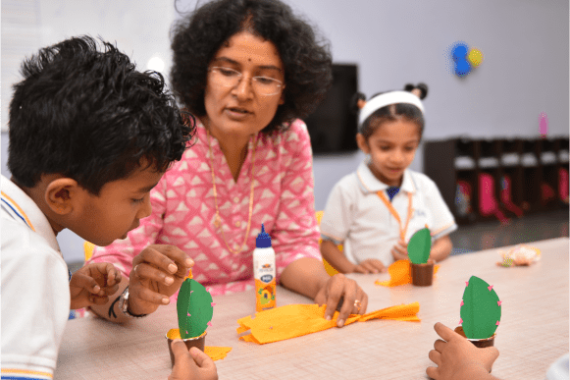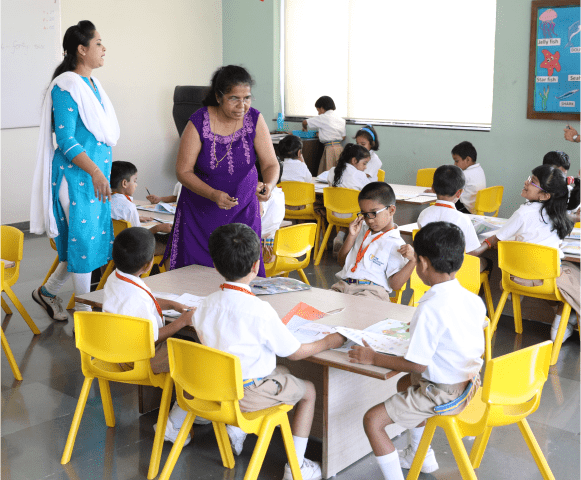Finland’s big new export to India: Education
Schools offering activity-based learning over textbook-based education are emerging across India.

Bengaluru, India– Playdough is not a common mathematics teaching aid. But at Jain Heritage School in the upmarket neighbourhood of Whitefield in Bengaluru, India’s tech capital, it is among the options that primary school teachers use to make numbers fun.
Instead of learning by rote, children are encouraged to shape playdough into different numerals. They learn patterns using sticks and stones; counting by tallying up the trees they see during an outdoor exercise; and measurements by making lemonade.
Keep reading
list of 4 itemsAustralian universities’ allure dims for Chinese, Indian students
Crisis leaves Indian students in Ukraine worried
Academic freedom is under attack in Modi’s India
The schooling style is a sharp break from the doctrinaire approach that has long dominated Indian education: Government agencies draw up curricula, teachers and schools have little flexibility to innovate, and students are graded on what they remember rather than what they understand. This, on the other hand, is an attempt at emulating Finland’s globally acclaimed school system, which is now gaining traction 6,500km away in India.
Schools offering “Finnish education” are emerging across Indian cities, emphasising activity-based learning, interaction with nature and life skills over textbook-based, test-oriented education. The Academy School (TAS) in the city of Pune adopted a Finnish curriculum last year. Finland International School, also in Pune, will start later this year. FinlandWay, a Helsinki-based preschool provider, is setting up three institutions in Mumbai. There is Nordic High International School in Indore and Ramagya Roots, a pre-school in Noida.
Even Mohan Bhagwat, the chief of the Rashtriya Swayamsevak Sangh — the mothership Hindu nationalist organisation that the country’s ruling Bharatiya Janata Party belongs to — has publicly acknowledged the successes of Finland’s schooling system.
Some experts are worried that Indian private schools — mostly catering to children from privileged backgrounds — will not be able to ensure equal access to quality education and teaching, a foundational principle of Finland’s public school-based model. But the allure is real for parents like Pragya Sinha, a Pune-based marketing executive nervous about her eight-year-old son returning to the pressures of the classroom after studying from home during the pandemic.
“What’s really appealing to me is the personalised attention that these schools promise to students and that learning seems like fun,” Sinha told Al Jazeera. She is thinking of seeking admission for her son in either TAS or Finland International School. “We’re in a global village today — why should my geography limit my child’s education?”
‘Global village’
That is Finland’s pitch to the world, too. In 2015, the country’s government created a platform called Education Finland with the task of exporting the country’s education model that is routinely near the top in the OECD’s Programme for International Student Assessment (PISA) tests and that boasts a high school graduation rate of more than 90 percent. The organisation works with Finnish companies that identify global markets, find partner schools and customise pedagogy for specific countries.
“Systems in one country cannot be copied as such,” Jouni Kangasniemi, programme director at Education Finland, told Al Jazeera. “However, many good practices can be exported and adapted in another environment.”
India is not the only country looking at Finland. In Peru, the government is building 75 schools modelled on the Finnish experience, Kangasniemi said. New Nordic Schools, a Helsinki-based company, is helping new schools start in Brazil and in Minnesota in the United States, co-founder Pia Jormalainen said.
But the size of the Indian education market — expected to touch $225bn by 2025 — makes it a rare prize. New Nordic Schools and an Indian partner company, Finland Education Hub, are responsible for the curriculum and teacher training at Jain Heritage School and Nordic High International.

Alien schooling system
It is not always easy for Indian teachers and schools to adopt the Finnish model, said Jormanainen. While Finland has a core curriculum, teachers are expected to develop teaching and evaluation plans on their own. In India, teachers are trained to follow government-prescribed syllabi and textbooks. “We’ve had schools ask us to craft the syllabus for their teachers,” Jormanainen told Al Jazeera. “That’s fundamentally against our approach.”
Parents will also take time to accept an alien schooling system, said Shashank Goenka, whose Goenka Global Education group is launching Finland International School in Pune. At Finland International School, every class will have two trained teachers — one Finnish, the other Indian — and an assistant. “We want to deliver the best of the Finnish model in an Indian context,” Goenka told Al Jazeera.
That needs modifications to the Finnish schooling approach, said Ashish Srivastava, CEO of Finland Education Hub. Students in the Nordic nation do not take school work back home. But many Indian parents find the absence of any homework hard to understand, he said. “So our schools occasionally give activity-based exercises that kids and parents can do at home,” Srivastava told Al Jazeera. When parents ask schools why their children are not learning how to write with pens sooner, they are gently reminded that most people hardly write with pens any more. “That’s what we keep emphasising — the Finnish system is all about teaching children what’s relevant.”
But rigorous teacher training is the cornerstone of Finland’s education success, experts said. Until Indian teachers are trained afresh, schools have no alternative but to hire teachers from Finland. That is costly and reflects in the fees: Finland International School, for instance, charges 570,000 rupees ($7,600) a year, in a country where per-capita gross domestic product (GDP) hovers under $2,000. And while India has far more expensive private schools, Jari Lavonen, a professor at the faculty of educational sciences at the University of Helsinki, said he worries that the commercialisation of his country’s schooling approach “can hurt the image of Finnish education”.
“It is not fair to establish private schools and sell Finnish education,” Lavonen told Al Jazeera. But he acknowledged that since private schools already exist in India and other nations, injecting Finnish approaches into these institutions might make sense. “I know that in some countries, children who are studying in a Finnish-style private school are quite happy.”
Meanwhile, public schools are starting to adopt lessons from Finland, too. The education minister of Kerala, arguably home to India’s best government-run schools, announced earlier this month that the state would partner with Finland on teacher training, curriculum reforms and classroom technology. And even private schools are eyeing smaller cities and towns, said Goenka, portending a spread beyond major metropolitan regions soon. “We’re just getting started,” he said.